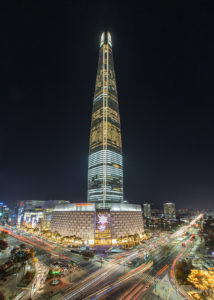This story originally appeared on The Moodie Davitt Report, our content share partner.
Lotte Duty Free posted all-time record sales of more than KRW 7.5 trillion ($6.7 billion) at its Korean stores last year, the company revealed last night.
Sales rose 25 percent year-on-year to the highest level in the travel retailer’s 38-year history.
Sales at Lotte Duty Free’s flagship store in Myeong-dong, Seoul exceeded KRW 4 trillion ($3.6 billion), a landmark reached on December 14. That all-time high represented an approximate 35 percent increase year-on-year.
Lotte Duty Free World Tower posted sales of more than KRW 1 trillion ($895.4 million), joining what the retailer dubbed the “One Trillion Club” on December 23.
That represents an 80 percent increase year-on-year for the Jamsil, Seoul store, which reopened on January 5, 2017, 193 days after it was forced to close on June 26, 2016 due to the loss of its license in an open tender.

Lotte Duty Free World Tower joined the “One Trillion Club” on 23 December.
Lotte Duty Free said that the World Tower store’s excellent tourist services and differentiated luxury brand offer had generated “remarkable achievements” in 2018. This was despite the proliferation of new duty free stores in the Gangnam area, the retailer commented.
Despite industry difficulties posed by the THAAD dispute between South Korea and China, sales of small and medium enterprise (SME) Korean brands at the World Tower store increased by 300 percent year-on-year. This contributed to a “win-win relationship” with SMEs, Lotte said.
Increased demand by daigou shoppers “greatly influenced” sales said Lotte. The retailer noted that such travelers had compensated for the “stagnation” of conventional Chinese tourism since the THAAD dispute erupted in March 2017. However, Korean travel retail executives and observers are closely monitoring the impact of China’s new e-commerce law, introduced on January 1, 2019, which is expected to hit the daigou business hard.
Online boom
Lotte Duty Free’s online sales boomed by 50 percent year-on-year to KRW 2 trillion (almost $1.8 billion) in 2018. That represented around 25 percent of total revenue compared to just 8 percent in 2013, a more than tripling of share. Lotte attributed the gains to improvements in its online and mobile platforms, allied to successful promotional initiatives.
Investment pays off
Lotte Duty Free said that heavy investment in improved facilities had reaped rewards. In August 2016, the Myeong-dong store’s 12th floor was expanded to ease shopping congestion and enhance the offer. In October 2018, Lotte opened a revamped “Star Avenue Corner” on the first floor of the flagship store and ‘Blooming Beauty’, a 519sq m shop-in-shop that houses around 130 brands, 60 of them SME labels and 30 of them independently owned.
“Through this, we are diversifying brands and achieving mutual growth,” Lotte said. In April last year, the company unveiled its KRW10 billion ($9 million) Star Lounge in Myeong-dong for top VIP customers. Invitations to brand events for houses such as Chanel and Swarovski have generated “hot reaction” among customers, the company said.
The story so far
Lotte Duty Free started trading in 1980 at its Myeong-dong store. It has been South Korea’s number one duty free retailer ever since (and the Myeong-dong shop the country’s most popular door). Annual sales reached KRW 2.2 billion in 1980 (just under $2 million at today’s exchange rates), rising to KRW 1 trillion ($895.4 million) by 2011 when South Korea’s Chinese tourism boom began.
Sales rose to KRW 2 trillion in 2015, and KRW 3 trillion in 2016.



